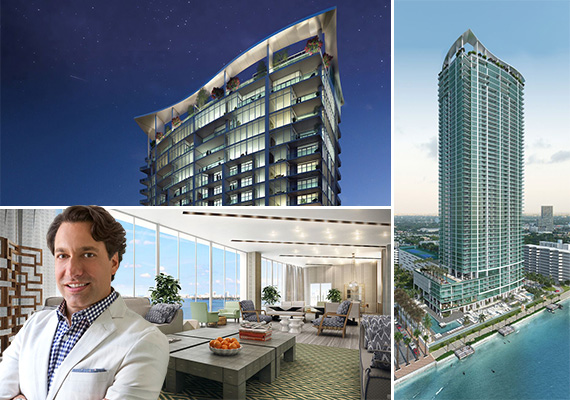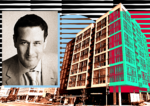Trending
Q&A with Thom Filicia: Queer Eye star is designing interiors for Biscayne Beach

Long before the TV series Queer Eye for the Straight Guy made Thom Filicia famous, the New York-based interior designer frequented Miami. He came as a child to see grandparents who lived in South Florida and as a college student to enjoy Spring Break. As an adult, he often visited socially with a long-time boyfriend who grew up in the Miami area and came professionally for projects in private homes.
Filicia now is working in Miami on his biggest commercial project yet: interiors for Biscayne Beach, a 399-unit luxury condo tower in city’s Edgewater area. He visited South Florida this month to work on that project and to headline a Miami Beach edition of Times Talks, the event series in which New York Times writers interview notable personalities.
Filicia, 47, set up his namesake firm, Thom Filicia Inc., in 1998 after graduating in interior design from Syracuse University and working for such top design companies as Parish-Hadley and Robert Metzger. His firm now employs 21 people, with clients from actress Tina Fey to Rosewood Hotels & Resorts and Delta Airlines.
For his line of furniture and accessories, Filicia also has to-the-trade showrooms, called Sedgwick & Brattle, in New York City and High Point, North Carolina. He’s now considering a Miami showroom, “because we like what we’re doing here and how the city is maturing and growing,” he said.
Down to earth and playful, wearing suede loafers without socks, Filicia spoke with The Real Deal in Miami Beach. The interview has been edited for space and clarity.
Q. Tell us about your Biscayne Beach project on the bay at 711 Northeast 29th Street.
A. We’re working with a group from New York City and Palm Beach on a 399-unit building, with 52 floors. We’re doing all the public, common areas like the reception, some beach areas, hallways, elevators, and on the fit and finish of the units like the doors, trim, kitchen cabinets, faucets and bathroom amenities. We may also offer furniture and interior packages to the people moving in.
This is our first commercial project in Miami. I’ve done homes here — a house on La Gorce Island many years ago, a condo on Collins in the 50s on the ocean. This is our biggest project so far and probably the most fun. I remember touring the site more than a year ago, when it was a two-story, motel-y thing. It’s been fun to conceptualize what we were going to do with the building, the lifestyle of it, its identity.
The story we’ve created is sort of city-meets-beach. We wanted the building to feel connected to the water but have a different point of view on this side of the bay near the Design District and Wynwood. We wanted it to feel friendly and approachable, yet sophisticated and stylish enough to be in a city.
For our design, we selected materials that show a balance of urban and earthy. We use travertine as opposed to marble, because it’s more organic. We use honed stones as opposed to polished. We use shell stone, which is shells ground up into concrete, as pavers to bring in that beach element.
To counter-balance the steel and glass, we’ve chosen a lot of woven elements – linens, walls with a grass-cloth kind of look, window treatments that are mesh, not shiny or silky.
Q. How does work on a commercial project differ from design for a private home?
A. On these bigger projects, you’re looking at things not only from a design standpoint but also from a cost, practicality and usability standpoint. You had to make choices as part of a bigger picture.
On a personal project, the person gives you the lifestyle. With a building, you create the identity and the lifestyle to appeal to a certain demographic. It’s like if you put on a lot of jewelry and a very expensive outfit and go out, you’re going to appeal to a certain group. But if you have a linen dress on and sort of a cool bracelet and your hair is pulled back, you’re probably going to appeal to a different person and may even have a different experience. And that’s what makes this building different than the one next store. It’s our ability to give it an identity and a soul. Design without a soul feels very flat.
Q. How is designing for Miami different?
A. Even though Miami is becoming one of the most important American cities, people when they’re here still want to feel like they’re on vacation. Nobody really wants to feel like that in L.A. or New York City.
There’s an element of Miami connected to the idea of surrendering yourself to relaxing. It’s something playful and authentic. Some of the most interesting places in Miami for me have that sense of ease, an organic element connected to the water and the idea that flip-flops are not off-limits.
Q. How did you get involved with Biscayne Beach?
A. I was introduced to the project developer, Reid Boren of Two Roads Development, through a realtor, Alicia Cervera Lamadrid. I met Alicia through my boyfriend at the time, who grew up here.… I’ve been coming to Miami since I was in elementary school. I feel like I’ve matured with the city.
Q. Where else are you working now?
A. We’re doing projects in Montana, Colorado, Connecticut, the Hamptons, New York City, Turks and Caicos and in Mexico. And we’re in talks for another commercial building near Miami but closer to Palm Beach.




